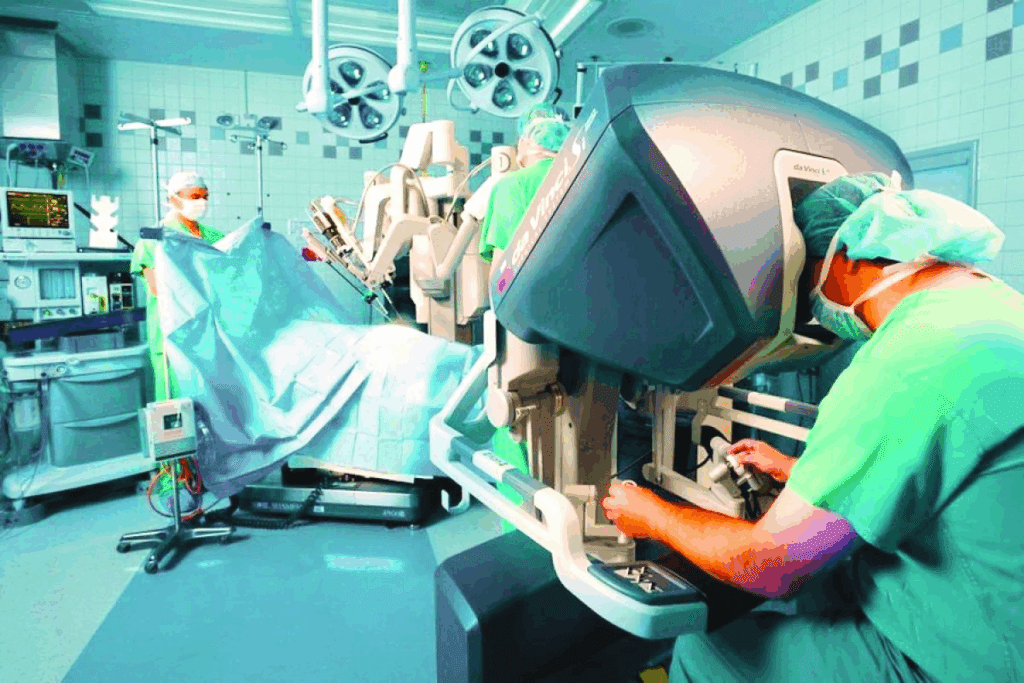Last Updated on November 27, 2025 by Bilal Hasdemir

Robotic surgery is getting more popular, with the Da Vinci Surgical System leading the way. It has been used for over 6 million surgeries worldwide. This shows how widely it’s accepted.
The cost of robotic surgery worries both patients and healthcare workers. The Da Vinci robot is expensive to buy and run. This adds to the total cost of surgeries.
As robotic surgery becomes more common, it’s important to understand the costs. This is true for both patients and healthcare systems.

The Da Vinci Surgical System is a cutting-edge robotic platform for complex surgeries. It has changed surgery by giving surgeons better vision, precision, and control.
The Da Vinci Surgical System is a minimally invasive surgical platform. It lets surgeons do complex procedures with great precision. It has a surgeon’s console, a patient-side cart, and a vision system.
The system’s robotic arms move like a surgeon’s hands. This allows for detailed movements during surgery.
Robotic surgery has grown a lot, with the Da Vinci System leading the way. It was first approved by the FDA in 2000 for some heart procedures. Over time, it has been updated to help with many other surgeries.
The Da Vinci Surgical System is used for many surgeries in different fields.
In gynecological surgeries, like robotic hysterectomies, the Da Vinci System shines. It helps patients recover faster and have fewer complications.
Urological surgeries, like prostate removals, also use the Da Vinci System. It offers better vision and dexterity, helping to save more tissue.
The Da Vinci System is also used in general surgeries, like laparoscopic procedures. It’s often compared to traditional surgery. The Da Vinci System is better because it causes less trauma and leads to quicker recovery.

Robotic surgery costs include the initial buy and ongoing expenses. We look at the Da Vinci Surgical System’s costs.
The Da Vinci Surgical System costs between $1.5 to $2.5 million. This is a big deal for hospitals thinking about robotic surgery.
Hospitals also face ongoing costs. This includes yearly maintenance fees, which can be $100,000 to $200,000. Training for surgical staff adds to these expenses.
Robotic surgery costs are often passed on to patients. Here’s how:
Facility fees cover the use of the hospital’s equipment, like the Da Vinci System. These fees vary by hospital and location.
Surgeon fees include pre-op, surgery, and post-op care. These fees depend on the surgeon’s experience and time.
Equipment charges are for using the Da Vinci System. These costs are high because of the system’s price and upkeep.
The total patient cost is the sum of these fees. It’s key for patients to know this when talking about treatment with their doctors.
When you’re thinking about surgery, it’s key to know the cost differences. This includes robotic, laparoscopic, and open procedures. These costs can affect both healthcare systems and patients.
Laparoscopic and robotic surgeries are both minimally invasive. But, they have different costs. Robotic surgery, like with the Da Vinci Surgical System, often costs more at first. This is because of the expensive equipment and upkeep.
A study showed that robotic surgery can lead to shorter hospital stays and less blood loss. But, the total cost is higher. This is mainly because of the robotic instruments and maintenance.
Open surgery is more traditional and often more invasive. It has different cost implications than robotic surgery. Open surgery might have lower initial equipment costs. But, it can lead to longer hospital stays and recovery times. This can increase overall healthcare costs.
The cost difference between robotic and traditional surgeries depends on the procedure. For surgeries like hysterectomy and prostatectomy, robotic surgery is often chosen. This is because it’s less invasive and leads to quicker recovery.
Robotic surgery for hysterectomies can be pricier than traditional methods. This is mainly because of the robotic system’s cost. Yet, some studies suggest that the shorter hospital stay and quicker recovery can make up for some of these costs.
Robotic surgery for prostatectomy might have similar or slightly higher costs than open surgery. But, it offers benefits like shorter hospital stays and less blood loss.
Cardiac procedures’ cost comparison is complex. It depends on the specific procedure and healthcare provider. Robotic-assisted cardiac surgery is less common but is growing in use.
In summary, robotic surgery is often more expensive than traditional methods. But, the overall cost impact depends on factors like hospital stay, recovery time, and the procedure itself.
Understanding insurance for Da Vinci surgeries can be tricky. Coverage varies a lot among different providers and policies.
Medicare and Medicaid usually cover Da Vinci surgeries for some procedures. Medicare covers them if they’re medically necessary. Medicaid coverage depends on the state.
“Robotic surgery is becoming increasingly common, and insurance coverage is evolving to accommodate this trend.” –
A Surgeon
Private insurance for Da Vinci surgeries is different. Some insurers pay for everything, while others might ask for big copays or deductibles.
| Insurance Provider | Coverage for Da Vinci Surgeries | Out-of-Pocket Expenses |
| Blue Cross Blue Shield | Covered with pre-authorization | $500 deductible, 20% copay |
| Aetna | Covered for certain procedures | $1000 deductible, 30% copay |
Patients can face big costs for Da Vinci surgeries.
Deductibles and copays change a lot. It’s key to check your policy to know what you’ll pay.
Many insurers need pre-authorization for Da Vinci surgeries. It’s important to talk to your insurer about this.
Patients undergoing robotic surgery often face extra costs. These can affect their financial situation. Costs come from the surgery itself, hospital stay, recovery time, and follow-up care.
Robotic surgery means shorter hospital stays. This is because the procedures are less invasive. Even though the stay is shorter, the daily hospital costs can add up. Studies show robotic surgery can cut hospital stays by 1-2 days.
Robotic surgery leads to quicker recovery times. This means patients can get back to their daily lives faster. This is great for those with work or family commitments.
After robotic surgery, patients need ongoing care. This includes doctor visits, tests, and medication. Medication and rehabilitation costs are also key during recovery.
Medication costs during recovery can vary. Patients might need pain meds, antibiotics, and other drugs to heal.
Rehab costs include physical and occupational therapy. These help patients regain strength and mobility.
It’s important for patients to understand these hidden costs. Knowing all the costs helps them prepare financially for robotic surgery.
Looking at the value of robotic surgery means checking its effects on patients. The Da Vinci Surgical System leads in this field, bringing many benefits.
The Da Vinci System offers enhanced precision and flexibility in surgery. This leads to better results for patients. Research shows it causes less blood loss and fewer complications than old methods.
Patients who get robotic surgery often have shorter hospital stays and faster recovery times. This means they face less postoperative pain and fewer complications. It makes their life better overall.
Looking at the cost-effectiveness of robotic surgery means looking at both short-term and long-term benefits.
In the short term, robotic surgery can mean reduced hospital stay costs and less need for postoperative care. Long-term, it can mean reduced risk of complications and fewer readmissions.
Patient happiness is key in judging robotic surgery’s value. Studies show patients are more satisfied because they feel less pain and can get back to normal faster.
| Outcome Measure | Robotic Surgery | Traditional Surgery |
| Average Hospital Stay | 2.5 days | 4.2 days |
| Complication Rate | 5% | 10% |
| Patient Satisfaction Rate | 85% | 70% |
Robotic surgery costs vary a lot from one place to another. This is because of many factors. The cost can change a lot based on where you are, the type of hospital, and how many surgeries are done there.
Hospitals in cities usually charge more for robotic surgery than those in rural areas. This is because of higher costs, more demand, and fewer skilled people in cities.
Costs for robotic surgery also vary by state. Things like state laws, insurance, and the number of special hospitals play a big role.
Hospitals that do a lot of robotic surgeries might charge differently than those that don’t.
Centers that do a lot of surgeries can offer better prices because they are more efficient and experienced.
Teaching hospitals, which focus on research and training, might have different costs than community hospitals. The presence of students and research can affect the cost of care.
In summary, the cost of robotic surgery changes a lot depending on where you are, how many surgeries are done, and the type of hospital. It’s important for patients and healthcare providers to understand these differences to make good choices.
The world of robotic surgery is about to see big changes in its economics. As it grows, several things will affect the cost of these surgeries.
The Da Vinci Surgical System is facing new competition. Medtronic and Johnson & Johnson are making their own robotic systems. This could lead to lower prices as the market gets more competitive.
New tech in robotic surgery is making things better and cheaper. Artificial intelligence and machine learning are making these systems smarter. This could mean less need for expensive upkeep and training.
With more competition, prices for robotic surgery are likely to drop. But how fast they drop will depend on a few things. These include how competitive the market gets and what rules are in place.
More competition means better deals for hospitals and surgical centers. With more options, they can negotiate lower prices for robotic systems.
Rules from regulatory bodies also shape the cost of robotic surgery. Changes in these rules can affect how much robotic systems and surgeries cost.
| Factor | Impact on Costs | Timeline |
| Emerging Competitors | Potential decrease in system costs | Short-term (1-3 years) |
| Technological Advancements | Reduced maintenance and training costs | Medium-term (3-5 years) |
| Regulatory Changes | Variable impact on costs | Variable |
Patients and healthcare providers need to think about many things when deciding on robotic surgery. The Da Vinci Surgical System has changed surgery a lot. It offers benefits like less recovery time and better precision.
When looking at the costs of robotic surgery, it’s key to think about more than just the upfront cost. The long-term benefits and outcomes are also important. Even though robotic surgery might cost more than traditional methods, the better results and shorter hospital stays can save money in the long run.
To make good choices about robotic surgery, you need to understand the costs, benefits, and possible results. By looking at these factors, patients and doctors can make choices that fit their needs and goals. The future of robotic surgery is bright, with new technologies and competitors to the Da Vinci System coming along.
In the end, making smart choices about robotic surgery can lead to better health and a better life. As healthcare keeps changing, it’s important to stay up to date on robotic surgery. We should carefully think about the costs and benefits of this new technology.
The Da Vinci Surgical System is a robotic tool for surgery. It’s used for many operations, like gynecology, urology, and general surgery.
A Da Vinci robot costs between $1.5 million and $2.5 million. This price depends on the model and its features.
Robotic surgery costs include the robot itself, upkeep, and training. There are also fees for the hospital, the surgeon, and equipment.
Robotic surgery might cost more than traditional surgery. But, prices change based on the procedure, hospital, and where you are.
Insurance for Da Vinci surgery varies. It depends on your insurance, policy, and the surgery. Medicare and Medicaid cover some procedures.
Patients pay for deductibles, copays, and need pre-authorization. These costs differ based on your insurance.
Yes, there are hidden costs. These include hospital stay, recovery time, and follow-up care. There are also medication and rehab costs.
Robotic surgery offers better outcomes and quality of life. It can also save money in the long run.
Costs vary by region. Prices differ in urban vs. rural areas, by state, and with volume-based pricing.
Future trends include new competitors to Da Vinci, tech advancements, and price predictions. Market competition and regulations will also affect prices.
Subscribe to our e-newsletter to stay informed about the latest innovations in the world of health and exclusive offers!